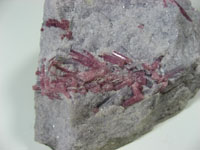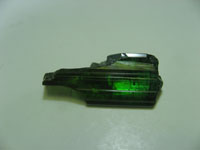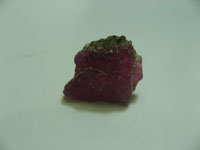![]()
Elbaite is a mineral in the tourmaline group which was first discovered in 1913 on the island of Elba Italy. Since that time, elbaite been found in many parts of the world. In 1994, a major locality was discovered in Canada, at O'Grady Lakes in the Yukon.
![]()
Within the metaphysical realm of minerals, elbaite, along with all other minerals in the tourmaline group, dispel fear and negativity, calms the nerves, gives inspiration and dispels grief. Sensuality is softened, concentration and eloquence improve and balance is restored in relationships. Sleep is more tranquil. Blood poisoning, consumption, anemia and lymphatic diseases are eased. All forms of tourmaline stimulate the bio magnetic, electrical and crystalline properties in the body. This electrical effect stimulates communication between the subtle bodies.
Please note that MIROFOSS does not suggest in any way that minerals should be used in place of proper medical and psychological care. This information is provided here as a reference only.
![]() Elbaite is generally used as a gemstone or collectors mineral. However, it can be used as a minor ore of the element Lithium.
Elbaite is generally used as a gemstone or collectors mineral. However, it can be used as a minor ore of the element Lithium.
![]()
Elbaite forms in igneous and metamorphic rocks and veins in association with lepidolite, microcline, and spodumene in granite pegmatites; with andalusite and biotite in schist; and with molybdenite and cassiterite in massive hydrothermal replacement deposits.
![]()
Elbaite is a sodium, lithium, aluminium boro-silicate mineral. Elbaite forms three series, with dravite, with liddicoatite, and with schorl. Due to these series, specimens with the ideal end-member formula are not found occurring naturally.
Other than in the basic mineral form, elbaite can be found in three distinct varieties:
![]()
| Cleavage | Indistinct | |
| Colour(s) | Blue, Colourless, Green, Yellow, Pink, White | |
| Specific Gravity | 3.05 | |
| Diaphaneity | Transparent to Translucent to Opaque | |
| Fracture | Sub Conchoidal - Fractures developed in brittle materials characterized by semi-curving surfaces. | |
| Mohs Hardness | 7.5 | |
| Luminescence | Fluorescent, Short UV - weak blue to white | |
| Lustre | Vitreous (Glassy) | |
| Streak | White | |
| Habit(s) | Prismatic to Striated | |
| Radioactivity | Non-radioactive | |
| Magnetism | Non-magnetic |
![]()
No known health risks have been associated with elbaite. However ingestion of elbaite, as with other naturally occurring minerals, is not recommended.
![]()
The following image shows the Elemental breakdown of the mineral topaz along with the mineral crystal structure.
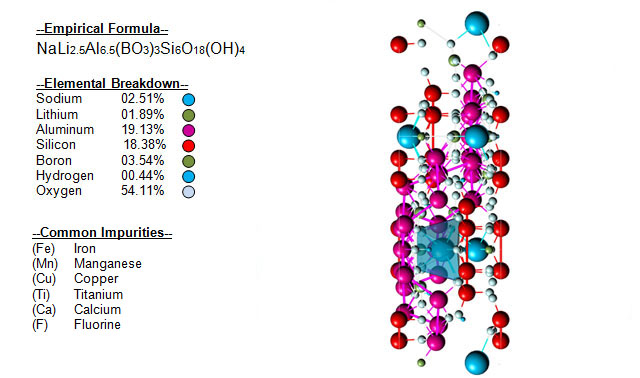
![]()
| Crystal System | Trigonal |  |
| Class | Pyramidal | |
| Axial Ratios | a : c = 1 : 0.44847 | |
| Morphology | Prismatic to Acicular | |
| Optical Data Type | Uniaxial (-) | |
| Dichroism (e) | Colourless | |
| Dichroism (w) | Colourless | |
| RL Values | nω = 1.633 - 1.651 nε = 1.615 - 1.630 |  |
| Pleochroism | Visable | |
| Max Birefringence | δ = 0.018 - 0.021 (See colour chart at right) | |
| Surface Relief | Moderate | |
| Dispersion | No | |
![]()
Elbaite can be referenced in certain current and historical texts under the following two names:
The mineral elbaite can be translated into the following select languages:
| Arabic | Bulgarian | Chinese (Sim) | 锂电气石 | ||
| Croatian | Czech | Danish | |||
| Dutch | Esperanto | Estonian | |||
| Finnish | French | German | Elbait | ||
| Greek | Hebrew | Hungarian | |||
| Italian | Japanese | リシア電気石 | Korean | 얠볟으 | |
| Latin | Lithuanian | Norwegian | |||
| Persian | Polish | Portuguese | |||
| Romanian | Russian | Эльбаит | Slovak | ||
| Spanish | Elbaita | Swedish | Tagalog | ||
| Turkish | elbait | Ukrainian | ельбаіт | Vietnamese |
![]()
Elbaite can be found in a few places around the world. The map below shows major documented concentrations of elbaite:
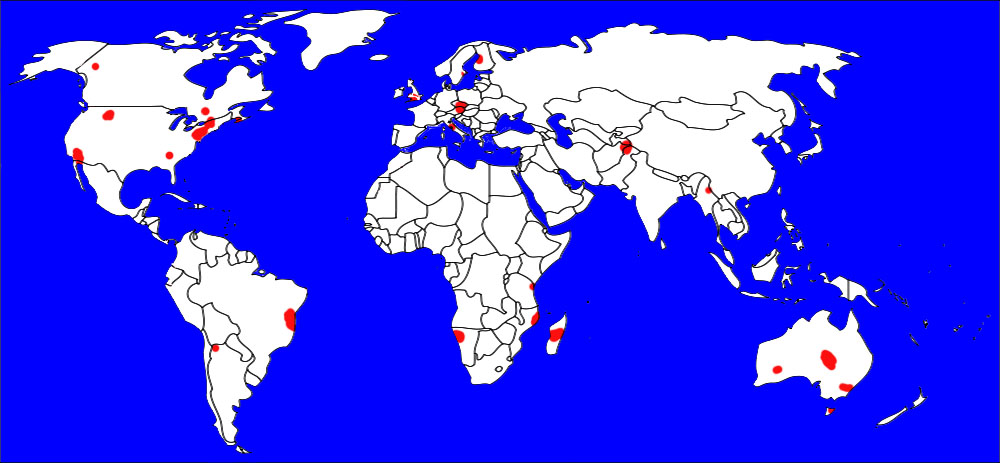
![]()
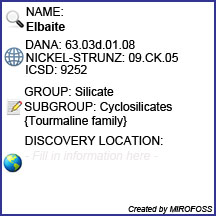 |
The MIROFOSS database offers free printable geological identification tags for personal and non-profit use. These tags can be used to properly identify mineral samples in your collection. -Click here- to download a full size jpeg image for an elbaite identification tag; which can be printed on paper or used with a plastic laser printer. |
 |
What's this? What can I do with it? |
![]()
| Chemical Composition | Grew, E.S., and Anovitz, L.M. (1996) BORON: Mineralogy, Petrology and Geochemistry, second edition, as revised (2002). |
| Crystallography | Bradley, J.E.S. & O. Bradley (1955), Observations on the colouring of pink and green zoned tourmaline Mineralogical Magazine: 30: 26-38. |
| Crystallography | Manning, P.G. (1969), An optical absorption study of the origin of colour and pleochrism in pink and brown tourmalines Canadian Mineralogist: 9: 678-690. |
| Crystallography | Donnay, Gabrielle & R. Barton (1972), Refinement of the crystal structure of elbaite and the mechanism of tourmaline solid solution: Tschermaks Mineral. Petrogr. Mitt.: 18: 273-286. |
| History | Agrosì, G., Bosi, F., Lucchesi, S., Melchiorre, G., and Scandale, E. (2006) Mn-tourmaline crystals from island of Elba (Italy): Growth history and growth marks. American Mineralogist: 91: 944-952. |
| Geograpcial Data | Mindat.org. Retrieved on 2012-10-24 |
| Physical Identification | Webmineral.com. Retrieved on 2012-10-24 |
| July 08, 2014 | The last time this page was updated |
| ©2017 MIROFOSS™ Foundation | |
 |
|

